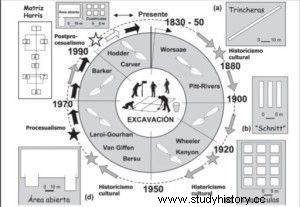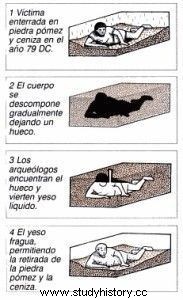Taking advantage of the fact that the International Archeology Day was on July 24, what better tribute to review the trajectory of the archaeological research project. From paper and pencil, to the pick or chisel .

And it is that the work of the archaeologist he is not only in the field; you have to start by secluding yourself in archives, libraries or town halls to review the various written sources that can present evidence of the existence of some deposit . Some of these fonts are from classical authors that locate relevant cities or tombs in a specific space, or from archaeological charts that show discovered deposits, excavated or not. Then, it is essential to consult geographic files current and past to be able to place them in a certain space.
When the cabinet work ends, and our suspicions are confirmed to a certain extent in writing, it is when we must materialize our starting hypothesis . Our hypothesis will change depending on the course of action, and it is something that must be assumed as soon as possible.
Therefore, after formulating our first idea about what we are looking for and consequently, what we want to find , we only have to get a specialized team and a promoter or public entity that supports our project. With all this and a work organization appropriate… We are on the right track!
Once our deposit is located in a certain space, it is time to step on the ground to check a priori that our hypothesis is close to what was proposed. This is called prospecting , a method that is increasingly used and that in future blog posts we will see its relevance in the archaeology of the future .
If prospecting gives the green light … comes the most complex part:excavation . Recalling Renfrew and Bahn's definition, it should be added that excavation is the destructive form to recover historical contexts. Therefore, they are unique and, consequently, irreversible.
To proceed with excavation, it is necessary to take into account the soil formation , because it will define the state of the deposit and what it contains. So, our key will be the stratigraphy .

Stratigraphy is something intrinsic in the very definition of Archaeology as a scientific discipline , and the different trends in the application of the method have given importance both to the horizontal plane (context) as to vertical (typology). One of the pioneers in attending to the order of the soil was Pitt-Rivers In the mid-nineteenth century, an ex-military follower of Darwin, established meticulousness in the collection of the archaeological record to be able to verify his artistic evolution within a cultural context (there is a museum named after him in Oxford).
Decades later, Mortimer Wheeler revolutionized the archaeological landscape by placing stratigraphy on the same level of importance as horizontal contexts. For this he created a different way of working based on a spatial organization of the work in grids created with stratigraphic witnesses . According to the layers of the earth, the archaeological evidence was recorded and until the excavation was finished, the witnesses were not destroyed to see the context in the area.
Until the middle of the 20th century, the excavation method it was a tool to know the evolution and chronology of the material record found, which was linked to a specific town or community. But all this changes at the hands of Ian Hodder, using a unique deposit:Çatal Höyük.

The scientific and stratigraphic method found a reason. The theoretical change suffered by Archeology at this time led to a change in archaeological practice itself. The post-processualism he created “area excavation”, a method used to understand the context and not the object. This method survived along with the Wheeler, although it finally prevailed over it.
What is certain is that depending on the type of deposit , wet, dry or derived from a single natural catastrophe, the method to be developed will be different. A nearby case and for which archeology gives thanks is Pompeii , an optimally preserved site for being buried under volcanic ash . This fact meant a preservation of the Roman city in extraordinary conditions. The excavation mode in this case it was particular, for example the bodies of the inhabitants of the city were recovered in plaster molds . In the number 2 of Archeology and history "The underworld of Rome", you can find an article about prostitution in the city buried by volcanic ash, an example of the information that could be found in this site thanks to its preservation.

The methods used up to now are not perfect and there is no single and universal methodology in archaeology, but bad practices. The improvisation in this work it is key, as we mentioned previously, the starting hypothesis will change according to the needs of the deposit; otherwise, theinterpretation it will be far from reality.
Last but not least, when the office work has offered us a starting hypothesis, the material is exhaustively collected, the excavation method has been appropriate to the context being excavated, the team has been competent and the breaks for the sandwich have been gladly taken advantage of; the next step will be laboratory and analysis . The interpretation of the results is the main objective of our work. It is time for phone calls to professional colleagues for doubts, consultations in jobs with similar characteristics... in short, it is time to go crazy.
And after that temporary madness , all the questions will have a more or less approximate answer, they will be put in writing and graphically the evidence found to finally expose society the final result, as the sole and main objective of our study.
From the archaeologist to society:by and for her…
Bibliography:
RENFREW. C, BAHN. P (2011):Archeology. Theories, methods and practices . Madrid:Akal.
